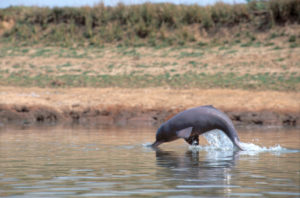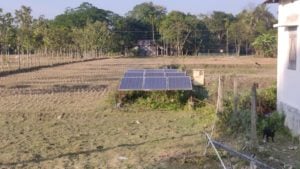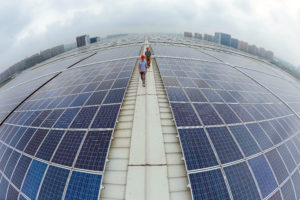“Climate change has a direct impact on the economies and well-being of our peoples. We notice changes in precipitation, in the amplitude of low water and high water. I would not call it a problem, I would call it a crisis,” said Bakhodur Rakhmonov, head of the Department of Foreign Economic Cooperation within Tajikistan’s Ministry of Foreign Affairs.
Seventy-two million people live in the countries of Central Asia (Kazakhstan, Kyrgyzstan, Tajikistan, Turkmenistan and Uzbekistan), mostly in rural areas. With agriculture a key sector of economies in the region, climate change poses a serious threat to the region’s food security and resilience.
Shrinking glaciers, more frequent droughts, more intense and frequent natural disasters, shifts in precipitation and changes in ecological systems have already become a threat to the region’s long-term socio-economic development. Building resilience and adaptation is increasingly becoming a topic on the regional agenda.
At the Climate Ambition Summit without ambition
On December 12, 2020, a virtual event took place to mark the five-year anniversary of the adoption of the Paris agreement and bring together global leaders to ramp up climate ambition.
Little had been expected from the Central Asian countries. The Covid-19 pandemic has brought serious socio-economic challenges to the region. Authorities have had to make decisions urgently and tackle pressing issues, including supporting overwhelmed healthcare systems, vulnerable populations, rising unemployment and downturns in economic activity. And, rather than looking towards a green transition, countries have given less priority to progress on climate targets.
Kazakhstan was the outlier. Speaking at the summit, Kassym-Jomart Tokayev, the president of Kazakhstan said, “Over the past 30 years, we have made great progress in terms of development. However, our economy relies on fossil fuels. Therefore, Kazakhstan has no other choice but to simultaneously solve two problems: move the economy away from fossil fuels and at the same time fight against climate change”. He then announced that Kazakhstan would achieve carbon neutrality in 2060.
While this stated ambition is welcome, Kazakhstan is set to miss its current targets – which are insufficient to meet the Paris agreement’s requirements.
The other Central Asian countries made no such statements. They have decided to focus their efforts on preparing for the 26th session of the conference of the parties (COP26) to the United Nations Framework Convention on Climate Change, which was postponed to November 2021 due to the pandemic.
Emissions are growing
Over the past decade, countries in the region have made some progress in integrating climate change issues into economic planning and decision-making.
Under the Paris agreement on climate change, all Central Asian countries have prepared and submitted emissions reduction targets called “national nationally determined contributions” (NDCs). Kazakhstan pledged to reduce its production of greenhouse gas (GHG) emissions by 15-25% by 2030 compared with 1990; Kyrgyzstanby 11.49-13.75%; Tajikistan by 10-20% “without attracting new substantial international funding”. Turkmenistan promised to stabilise or begin to reduce GHG emissions by 2030, although compared with 2010, a 19% increase in emissions is expected. Uzbekistan’s objective was to decrease specific emissions of GHGs per unit of GDP by 10% by 2030 from 2010 levels.
According to the Regional Environmental Centre for Central Asia (CAREC), a non-profit organisation that works with governments on environmental issues, two out of five countries – Kyrgyzstan and Tajikistan – have managed to keep GHGs below the 1990 baseline. But their total volume is projected to grow. (It should be noted that a sharp decline in emissions after 1991 in many countries of the former USSR was due to the collapse of the governments and subsequent economic breakdown, and not because of active measures taken.) In 2018, greenhouse gas emissions in Kazakhstan approached the level of 1990, and in Turkmenistan emissions have been growing since 2000.
Climate finance
Central Asian countries have limited expertise and resources to prepare for the projected consequences of climate change and minimise their impact. They are increasingly seeking financial support and technical assistance from a variety of sources, though the amount of funding for Central Asia and Eastern Europe remains one of the lowest relative to other regions, and in 2017–18 amounted to only USD 15 billion.
According to Climate Funds Update, a website that provides information on multilateral climate finance initiatives, between 2011 and 2019, Central Asian countries received about USD 0.5 billion in initiatives and projects related to adaptation to climate change and the reduction of GHGs. Countries have received or applied for finance from funds including the Global Environment Facility, Green Climate Fund and Adaptation Fund.
“There are investment projects and public funds that are not labelled as ‘climate related’, but which are extremely important in terms of adaptation or mitigation of emissions,” said Irina Bekmirzaeva, regional coordinator of CAREC’s Climate Adaptation and Mitigation Program for Aral Sea Basin project. “Countries are investing in afforestation efforts, clean energy, the water sector or agriculture reform. Due to the lack of comparable data it is difficult to calculate numbers, but the figures are higher than external sources involved.”
Anton Timoshenko, head of Little Earth, an environmental organisation in Tajikistan, said that while international support is important, countries should use more of their own resources to implement climate strategies and programmes, and remove existing contradictions between climate goals and economic development goals. “For example, on the one hand, the country asks for help in implementing adaptation measures, and on the other, it actively supports investments in the development of the coal sector,” he said. (Editor’s note: the author of this article also works at Little Earth)
Calls for action
A recent report from Climate Action Network in Eastern Europe, Caucasus and Central Asia (CAN ECCA), states that no country in Eastern Europe, the Caucasus and Central Asia is considering reducing greenhouse gas emissions by 2030.
Ahead of the December summit, environmental organisations in the region called on Central Asian governments to make more ambitious commitments, arguing that the actions of developed countries alone will not be enough to keep global warming to below 1.5 degrees Celsius above preindustrial levels.
“Every day, every tonne of carbon dioxide (CO2) brings us closer to the point of no return… The countries of Central Asia are already most vulnerable to climate change. It is time to take very seriously the competence of the public organisations, the potential of government and the reality of the climate crisis,” said Olga Boiko, co-ordinator at CAN EECCA.
In November 2020, environmental organisations in the region set out the need to focus on a green recovery to help countries overcome the consequences of the pandemic and contribute to the sustainable development of the region. In particular, they urged national governments to set targets for CO2 emissions reductions of at least 20% by 2030, and to ensure a transparent and inclusive process for developing national climate policies.
Whether any of this will end up in countries’ NDCs of the countries remains to be seen, but the costs of postponing decisions on the climate become more obvious by the day.
![<p>Kassym-Jomart Tokayev, president of Kazakhstan, at a press conference in 2019. Kazakhstan was an outlier in Central Asia at the Climate Ambition Summit in December last year, as it pledged to achieve carbon neutrality by 2060 [image by: Russian Government/Alamy]</p>](https://dialogue.earth/content/uploads/2021/01/Kassym-Jomart-Tokayev-Kazakhstan-president-2048x1264-1.jpg)








